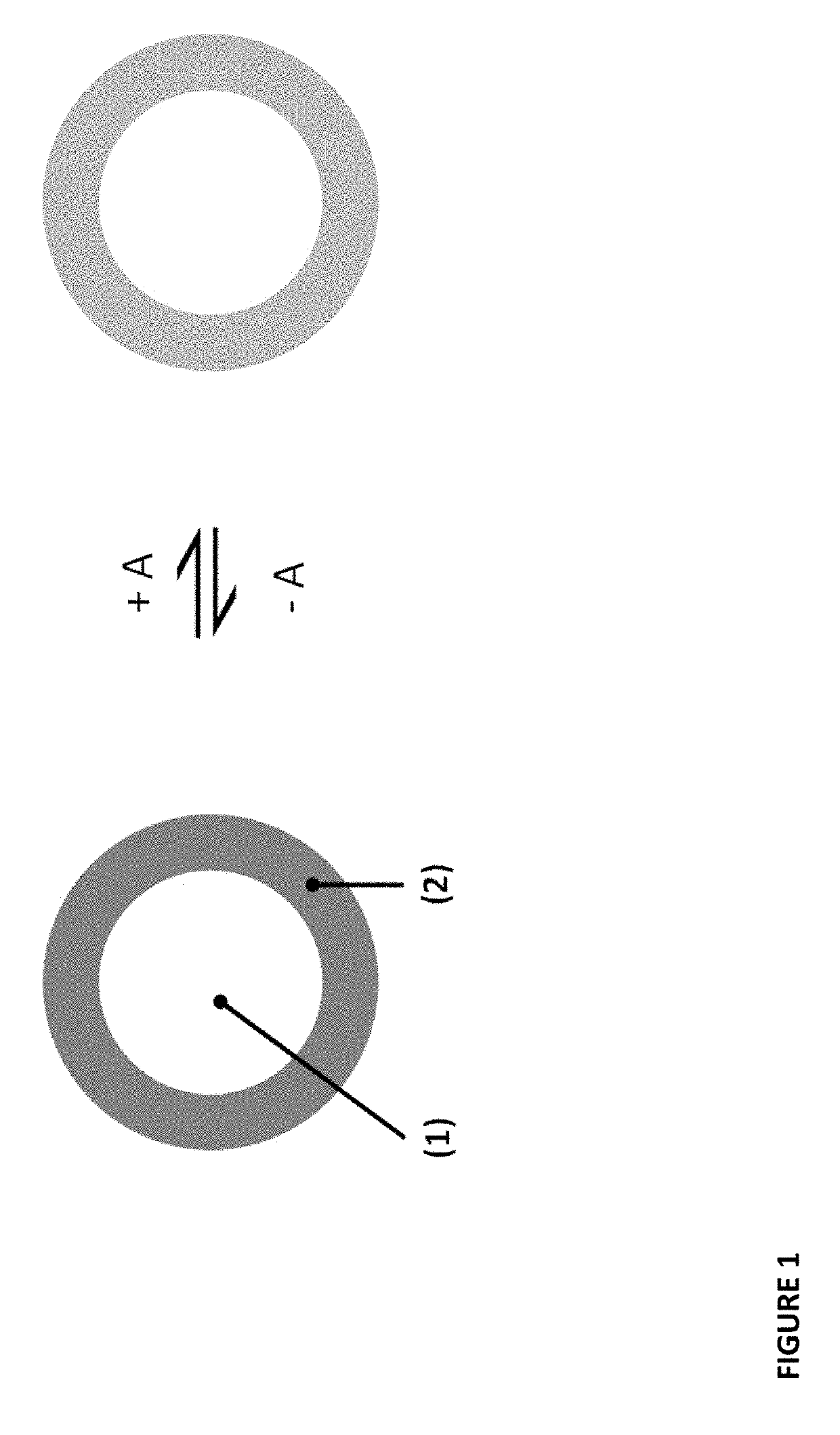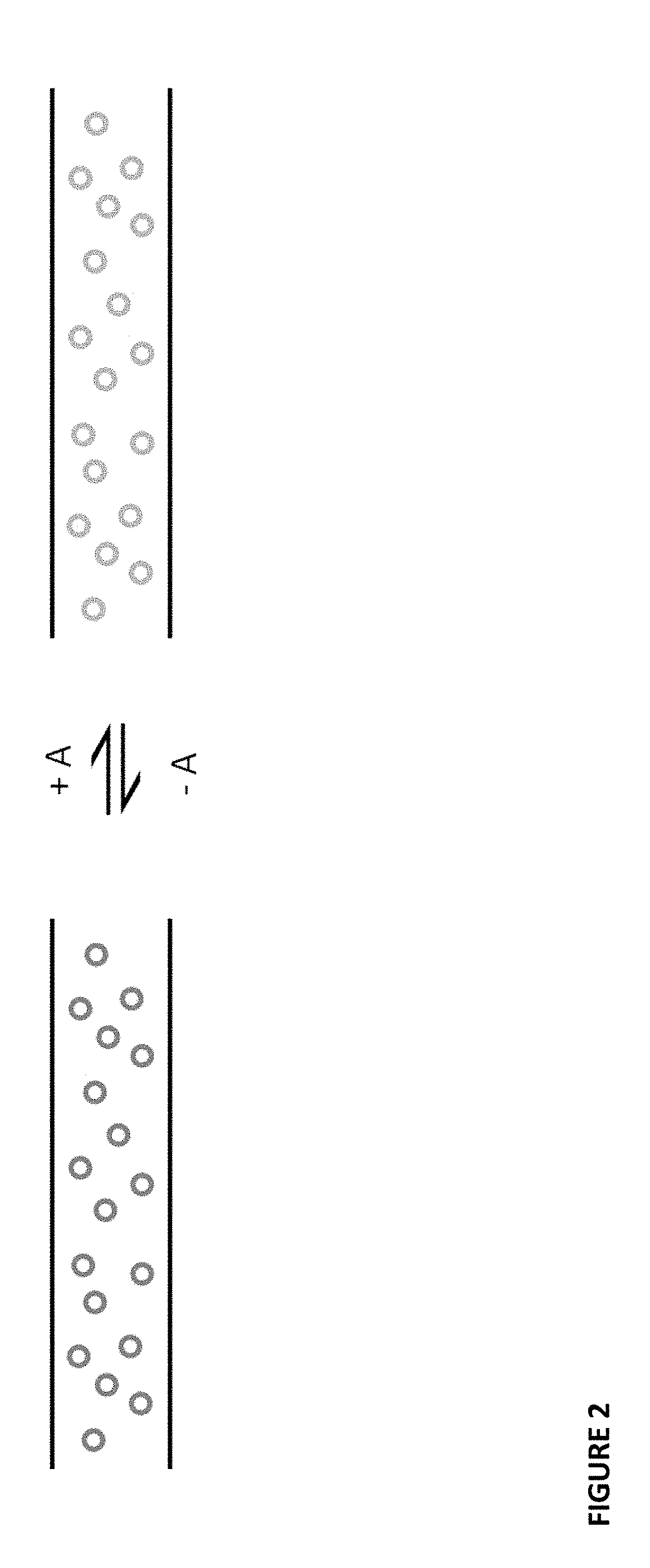Meltable color changeable indicators with organic polymer cores and methods of making such meltable indicators and composites thereof
a technology of organic polymer cores and indicators, which is applied in the direction of chemical indicators, analysis using synthetic resin layered products, coatings, etc., can solve the problems of instrument contamination and cross infection between patients, affecting the freshness or and affecting the quality of many packaged products. , to achieve the effect of maintaining the efficacy and stability of indicators, low melting point, and simple and reliable manufacturing
- Summary
- Abstract
- Description
- Claims
- Application Information
AI Technical Summary
Benefits of technology
Problems solved by technology
Method used
Image
Examples
example 1
[0080]Methods used to characterize the films are illustrated for an exemplary CO2-sensitive organic film: m-Cresol Purple (MCP) / low density polyehtylene (LDPE) / LDPE. Films were generated by the methods outlined above. In this example, both the core polymer and the bulk polymer are LDPE. Thickness for this film was measured at 55 um.
[0081]Color change response to the detected chemical substance is shown by color before and after exposure. All films were exposed to the detected chemical substance under test, for example, CO2 or ammonia, and the appearance of each film before and after exposure was recorded. See FIGS. 4A-F and 10A-C. A typical example is illustrated in FIG. 4A for the MCP / LDPE / LDPE CO2-sensitive film, which is blue in the absence of CO2 and yellow in its presence (100% CO2). Recovery spectra of the films were also recorded. See FIGS. 5A-C and 11A-C. These spectra show the spectrophotometric response of the films when exposed to the detected chemical substance (e.g. CO2...
example 2
[0092]Another CO2-sensitive organic film was created and characterized as described above. In this example, the film is TB (Thymol blue)-LDPE-LDPE. As before, color change response to the detected chemical substance is shown by color before and after exposure. See FIG. 4B. In this example, both the core polymer and the bulk polymer are LDPE. Thickness for this film was measured at 60 um. Recovery spectra of this film was also recorded, see FIG. 5B.
[0093]The value of α was calculated from UV-vis absorption spectra as before. FIG. 6B shows the spectra of the TB-LDPE-LDPE plastic film when exposed to the following different percentages of CO2 (from top to bottom at 615 nm): 0, 0.1, 0.21, 0.29, 0.43, 0.73, 1, 5 and 100%. This data reveals, via the insert plot for data at 615 nm, a R value (at 5% CO2) of 18.7 and an a value of 3.79±0.05 (R2=0.9991) where R=(Abs0−Abs) / (Abs−Absoc)=α % CO2. Thus CO2(S=1 / 2)=0.26. See FIG. 7, second entry.
[0094]As before, a response and recovery profile of th...
example 3
[0095]Another CO2-sensitive organic film was created and characterized as described above. In this example, the film is PR (Phenol red)-LDPE-LDPE. As before, color change response to the detected chemical substance is shown by color before and after exposure. See FIG. 4C. In this example, both the core polymer and the bulk polymer are LDPE. Thickness for this film was measured at 52 um. Recovery spectra of this film was also recorded, see FIG. 5C.
[0096]The value of α was calculated from UV-vis absorption spectra as before. FIG. 6C shows the spectra of the PR-LDPE-LDPE plastic film when exposed to the following different percentages of CO2 (from top to bottom at 586 nm): 0, 0.1, 1, 5 and 100%. This data reveals, via the insert plot for data at 586 nm, a R value (at 5% CO2) of 1.7 and an α value of 0.24±0.01 (R2=0.9995) where R=(Abs0−Abs) / (Abs−Abs∞)=α % CO2. Thus CO2(S=1 / 2)=4.2. See FIG. 7, 3rd entry.
[0097]As before, a response and recovery profile of PR-LDPE-LDPE plastic film was tes...
PUM
| Property | Measurement | Unit |
|---|---|---|
| particle size | aaaaa | aaaaa |
| melting point | aaaaa | aaaaa |
| melting point | aaaaa | aaaaa |
Abstract
Description
Claims
Application Information
 Login to View More
Login to View More - R&D
- Intellectual Property
- Life Sciences
- Materials
- Tech Scout
- Unparalleled Data Quality
- Higher Quality Content
- 60% Fewer Hallucinations
Browse by: Latest US Patents, China's latest patents, Technical Efficacy Thesaurus, Application Domain, Technology Topic, Popular Technical Reports.
© 2025 PatSnap. All rights reserved.Legal|Privacy policy|Modern Slavery Act Transparency Statement|Sitemap|About US| Contact US: help@patsnap.com



